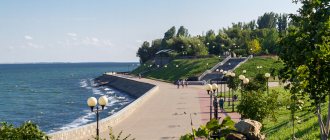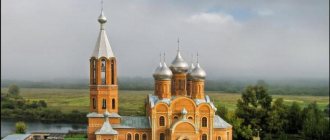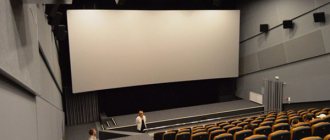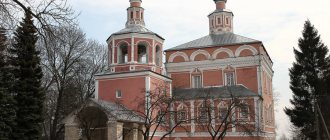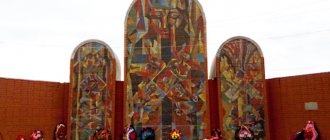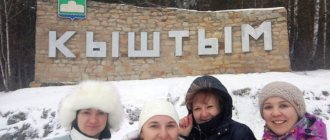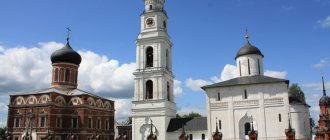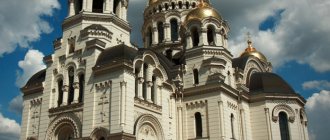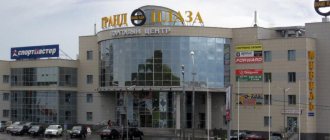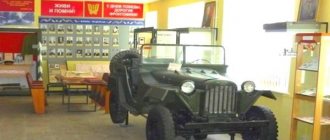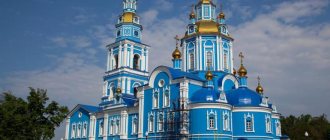1. Observation deck over the Kama River 2. Central square of Sarapul 3. Monument to Nadezhda Durova 4. Bashenin's dacha 5. Water pumping building 6. Tsar-house 7. Monument to the steam locomotive
On the May holidays of 2021 (May 10-11), it was decided to go to the city of Sarapul, located 67 km from the capital of Udmurtia, Izhevsk, on the banks of the Kama River. In terms of the trip, the main goal was to visit Bashenin’s dacha, the main attraction of Sarapul, a very interesting unique building. Read more about this.
Do you remember in the film “The Diamond Arm” the heroine N. Mordyukova asks Yu. Nikulin to give a lecture “Istanbul - a city of contrasts”? At that time, it was clear that the lecture had an ideological bias: the splendor and poverty of capitalist society as opposed to socialist society. So, the association... Most small Russian towns can safely be called the “City of Contrasts”. And in this case, the contrast lies in the condition of city buildings: some are looked after and are a decoration of the city, others are in deplorable condition, with trees growing on their roofs. And this immediately catches your eye: after all, these buildings stand next to each other, creating a real contrast!
Sarapul is no exception in this context. On the central square ALMOST everything is well-groomed, flowers are planted in the flower beds, a clean cozy embankment on the banks of the Kama River, a new beautiful building of the Sarapul Hotel. And then mixed in with all this beauty is something shabby, with birch trees on a leaky roof. Ehhh... City authorities, ah!
However, the central square of Sarapul is worth a stroll. Moreover, one of the historical attractions of this city is located there - a monument to Nadezhda Durova, a cavalry maiden, the prototype of Shurochka Azarova from the film “The Hussar Ballad”. However, we began our exploration of the city by visiting the observation deck above the Kama.
Museum and exhibition complex "Dacha Bashenina"
Bashenin's Dacha can rightfully be called Sarapul's calling card. This is a wonderful snow-white palace located among shady trees. The highlight of the structure is its appearance, which creates an optical illusion.
At first glance, it seems that the estate was built from wooden beams. In fact, stone was used for construction, imitating a wooden surface. Until 1917, the mansion belonged to the family of the merchant Bashenin. After the revolution it became national property. And in 1995 it was transferred to the Museum of History and Culture of Sarapul. In its halls you can see exhibitions telling about merchant life.
Location: Dostoevsky street - 60.
Beautiful temples and churches of Sarapul
It is difficult to imagine any locality in Russia, even a small one, without its own church. Sarapul is no exception. There are churches here that have been around for decades, and temples that have appeared quite recently.
Church of St. Nicholas the Wonderworker
- Address: st. Raskolnikova, 83A.
The construction of St. Nicholas Church began in 1995 with money raised by local residents, as well as working groups of Sarapul. The first divine service on the territory of the Orthodox shrine took place here only on January 6, 2009.
Today, work on painting the walls is still ongoing in the St. Nicholas Church, and preparations for the future iconostasis are also underway.
But already here the Cossacks managed to install the only Poklonny Cross in the city, at the foot of which they built a Golgotha. In addition, there is a memorial stone nearby, which is dedicated to everyone who suffered during the period of Soviet repression.
Church of Xenia of Petersburg
- Address: st. Gorky, 74, Central district.
The cathedral, dedicated to Xenia of St. Petersburg, was opened by the local Old Believer community in 1911. It existed under him until 1940. At the same time, the building was transferred to one of the military units to house a food warehouse. The cathedral was returned to the parishioners in 1991. Today there is an Orthodox parish here.
Church of the Intercession of the Blessed Virgin Mary
- Address: Internationalnaya st., 2A.
Almost on the embankment of the Kama River there is a beautiful Church of the Intercession, which is the oldest in the city. It was built between 1785 and 1792, which confirms this fact.
The architect of the Orthodox Church was F.M. Roslyakov. In addition to the throne of the Intercession of the Most Holy Theotokos, there are two other thrones here - Flora and Lavra, St. Nicholas the Wonderworker.
Church of Seraphim of Sarov
- Address: st. Seraphim of Sarov, 1.
The new church of the city is the Seraphim Temple, located in South Sarapul - it was built in the 21st century, between 2008 and 2013, in the original wooden design. Reviews confirm that there is a sincere atmosphere, wonderful servants and beautiful, original architecture.
Sarapul Annunciation Convent
- Address: st. Soboleva, 15.
In the northern part of the city there is the only monastery in Sarapul - Blagoveshchensky. The convent in these places was founded in 1811, and since 1923 it was closed by the Soviet authorities, almost completely destroyed. The current monastery complex is a new building, since construction work began only in 2015 and elsewhere.
Fire Tower
In 1889, a fire tower was erected in Sarapul. This is a large two-story building with a massive tower. According to city legend, a goat lived in the firemen's warehouse. He guarded the tower and scared away mice from the grain that was intended for the horses.
The animal came independently in the evening and left in the morning to the shopping area to refresh itself. Local traders immediately recognized him and fed the animal. This may be fiction, but locals still consider the legend to be reliable.
Location: Freedom Square.
Tsar-house
Tsar-house in Sarapul
In 1904, an outstanding entrepreneur and mayor of Sarapul, Pavel Bashenin, built a house in the Art Nouveau style. The building amazed contemporaries with its beauty. The arrow-shaped battlements that crowned the building resembled a crown, for which the townspeople nicknamed it “the king’s house.”
Bashenin’s “Tsar House” is one of the best buildings of its kind in the entire Kama region. It was in this building in Sarapul that an electric light bulb first lit up. After the revolution, the Palace of Labor was located here, and then a children's hospital. For a long time the object was in a dilapidated state, then it was under restoration. Now the building houses a diagnostic and treatment center.
Address: Sarapul, st. Truda, 15. Located a 5-minute walk from the embankment.
Estate of P. Koreshev
The house of timber merchant Pavel Koreshev differs from other city attractions in its quaint architecture. Before the revolution, the owners of the house lived on the second floor of the building, and on the first floor they kept a store and outbuildings.
Nowadays, Koreshev's estate has been restored and given the status of a historical monument. The Sarapul Wedding Palace began operating within its walls in 2011.
Location: Red Square - 7.
Koreshev's House is a historical site of special significance
This magnificent two-story building, built in 1907, successfully combines elements of two styles: neo-Baroque and Art Nouveau. The facade is decorated with patterns, columns, shields depicting coats of arms. The main door opens onto the street. Directly above it is a balcony with carved railings. There is an outbuilding adjacent to the house. The former owner of this example of Ural architecture, timber merchant P.F. Koreshev, carefully thought through all the details of the decoration and purpose of the building. On the second floor there were living rooms, and on the first floor there was an office and a store. Utility rooms, warehouses, and servants' housing were built in the courtyard.
The interior decoration of this fabulous palace is also distinguished by its sophistication. Here you can see interiors decorated with decorative elements, relief panels on the ceiling, amazing paintings on fireplaces, patterned doors and much more. After the revolution, the city council was located in this house, later it was equipped for
Museum of History and Culture of the Middle Kama Region
The building of the Sarapul Museum of History and Culture is considered an architectural value of republican significance. This is the oldest museum in the Udmurt Republic. Within its walls are preserved exhibits with a centuries-old history.
During the Great Patriotic War, the museum staff managed to preserve the personal belongings of the royals, brought from St. Petersburg. These days, the museum hosts literary evenings, traveling exhibitions and history lessons for schoolchildren.
Location: Pervomaiskaya street - 68.
Monument to N. Durova
In Sarapul, a monument was erected to the first woman, a hussar, who fought as an officer in the Battle of Borodino. Her name is Nadezhda Durova. She lived in the city for more than 30 years, and it was from here that she left to serve for the good of Russia. The famous Soviet film “The Hussar Ballad” was made in her honor.
The monument to Durova was erected in the summer of 2014 on the site where her parents’ house was previously located. The opening was timed to coincide with Sarapul City Day.
Monuments and sculptures in Sarapul
In the city of Sarapul there are a lot of monuments dedicated both to individual events in the history of Russia or a locality, and to personalities who glorified their homeland. Some of them are unique to modern Russia.
Cenotaph
- Address: DK Electron square.
The monument is located near the Elekond plant. It was dedicated to all the soldiers who died during the Second World War. More than one hundred mothers came here instead to the graves of their sons to honor their memory. And each of them always saw her own child in the figure standing on the pedestal. Veterans see their comrades in the sculpture’s outlines.
Monument to the Prisoners of the Death Barge
- Address: Kama River embankment.
During the Civil War, death barges were the floating prisons in which all detained and captured White Guards were kept. When they left the city, they placed there all those whom they suspected of sympathizing with the Bolsheviks as hostages.
The barge itself was placed at a pier located not far from Sarapul, in the village of Golyany. All of them were then subjected to torture by hunger, and some by cold due to the lack of normal clothing.
Periodically, the White Guards took some of the captured people out of the hold to shoot them. They were released in 1918 on October 17. But by that time, of the 600 people who were there initially, only 432 were able to survive.
Monument to Durova
- Address: Red Square, 6.
The monument was erected in Sarapul in 2013 in memory of the first female cavalryman, Nadezhda Durova, whose childhood years were spent in the city. She took part in a huge number of battles, in which she always showed herself to be a brave soldier. One of her main awards was the St. George Cross, received for saving an officer during the battle.
After her childhood, Durova visited Sarapul again in 1812, when she came here for treatment after being wounded during the Battle of Borodino. Later she was Kutuzov's orderly. But already in 1813 she returned to the cavalry again and took part in the battles to liberate German lands.
Durova retired only in 1816 - after her father’s urgent request. Then she returned to her hometown, where she surprised everyone with her men's suit. Nadezhda Durova died in 1866. She was buried with all the honors due to soldiers.
Fragment of a railway line
- Address: Naberezhnaya street.
This historical sign was opened in Sarapul in 2014. This was done early in the morning of June 22. In fact, these are the remains of a preserved railway line that operated during the war. Many trains carrying wounded people passed along it and came to local hospitals for treatment.
It was also along this route that in 1941 a train arrived with equipment from the Ordzhonikidze plant, which was previously located in Moscow. Quite a few food trains with products for both residents of Sarapul and other neighboring settlements passed through it.
Monument to Sivkov
- Address: st. Sivkova, 24G, Northern district.
A monument dedicated to the hero of the Soviet Union Sivkov was erected on the territory where the city school No. 17 is located. It was in Sarapul that the future soldier once spent his childhood, although he was born in Izhevsk.
He moved here in 1938, and subsequently graduated from high school here. By the end of 1943, he graduated from a tank school located in Kazan, after which he was sent to the 212th tank regiment.
In 1944, on the night before March 14, he managed to break into the village of Yavkino. There he independently managed to kill more than a hundred Germans, as well as destroy 3 guns and 12 armored personnel carriers belonging to them.
After that, in the process of maneuvering through the village to repel the fierce attacks of the Nazis, he got stuck in an anti-tank ditch. As a result of this, the entire crew immediately found themselves trapped. After they had completely used up all the remaining ammunition, Sivkov decided to set fire to the tank and blow up himself and his driver along with the car.
Monument-steam locomotive Ov-3705
- Address: Privokzalny residential area.
The locomotive was installed in memory of the Sarapul peasants, who in 1919, despite the scarcity of their own reserves, were able to send 80 pounds of bread they collected to St. Petersburg and Moscow. On the monument on the tender there is an inscription in memory of that gift from Sarapul to all the starving people from these cities.
Red Square Sarapul
To get a truly unforgettable experience of Sarapul architecture, visit the city's Red Square. From here you can enjoy a picturesque view of the Kama River. The square is located in the city center, framed on both sides by beautiful merchant houses of the late 19th century. Most of them are used as administrative institutions.
Observation deck "Mount Ural"
The site from which panoramic excursions are conducted was given the name “Mount Ural”. Although outwardly, it is most likely a large hill. A memorial sign to Andrei Durov (father of N. Durova) was installed on the hill. For a long time he was the mayor of Sarapul.
Another attraction of the hill is the Siberian larch tree. Its age is more than 200 years, it is considered the oldest tree in Sarapul. Local residents love this picturesque place. Wedding ceremonies and mass celebrations are often held here.
Sarapul Radio Plant Museum
In order to enter the territory of the radio plant and see the exhibits that are in its museum, you need to issue a special pass. This is because the Sarapul Radio Plant is considered a strategically important facility. The museum premises are spacious and bright.
Most of the collected exhibits are in working condition. To verify this, museum workers allow visitors to try them on their own.
Location: Gogol street - 40.
Water pump building
The Sarapul merchant Pavel Bashenin built towers in accordance with his surname. The building of his dacha and the building of the water pump were built in the form of towers. The photo below shows the most beautiful water pumping building in Sarapul, located on the Kama embankment. The station operated for its intended purpose until the mid-1980s of the last century. Today this building houses the modern restaurant and hotel complex “Old Tower”. Address: Sarapul, Opolzina street, 1
Sarapul. City water pump building
Temple of Blessed Xenia of Petersburg
Until 1911, the temple in the center of Sarapul was considered the parish of the Old Believers. Eighty years later, the building was consecrated and received the status of the Orthodox Church of Blessed Xenia of St. Petersburg.
The church was named after a woman whom the locals considered blessed. During the Great Patriotic War, the temple was transferred to the storage facilities of a military unit. Today, a large number of pilgrims come to Sarapul to visit the Temple of Xenia of St. Petersburg.
Location: Gorky street - 74.
What to bring from Sarapul
It is customary to bring souvenirs and gifts to loved ones from trips. I can offer several options that will remain as a memory or simply delight your family:
- cute souvenirs and magnets with images of P.A. Bashenin’s dacha and views of the city;
- vodka - the local distillery produces good alcohol, which many take away as a souvenir;
- “Bird's Milk” candies - in my opinion, no one makes them tastier than our factory;
- smoked sterlet - it is simply impossible to visit the Kama River and not bring back sterlet; this fish has long been delivered by locals to the court of Empress Catherine the Great;
- a painting by some local artist - they are sold and painted right on the embankment.
More recently, Sarapul was included in the list of cities with historical heritage and became one of 100 tourist cities. But no one is in a hurry to come here specifically for sightseeing. You can walk around the entire city and see everything in 1 day. You need to go to Sarapul to relax, enjoy nature and carefree days. Which, by the way, is what our guests do.
Marina, housewife, 41 years old
Filming location for the film "Volga-Volga"
Local residents of Sarapul are proud of the history of their city, its temples, merchant buildings, as well as such facts as the filming of the film “Volga-Volga” in 1938. People remember how the main character Lyubov Orlova lived in one of the houses in the village of Yaromsk. On the territory of the village there is the only two-story church in the Kama region, as well as the purest springs.
Church of Seraphim of Sarov
The modern architecture of Sarapul is in no way inferior to the ancient buildings. In 2008, on the outskirts of the city, near the forest, construction began on the wooden church of Seraphim of Sarov. The work was completed in 2013. Its appearance corresponds to the general ensemble of urban buildings. Metropolitan Nikolai of Izhevsk and Udmurtia consecrated the temple.
Location: Furmanova street.
